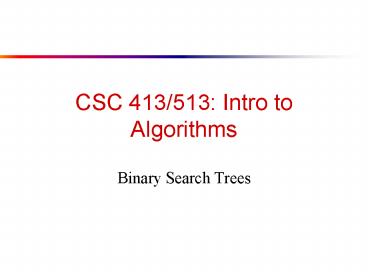CSC 413/513: Intro to Algorithms - PowerPoint PPT Presentation
1 / 24
Title:
CSC 413/513: Intro to Algorithms
Description:
CSC 413/513: Intro to Algorithms ... are an important data structure for dynamic sets In addition to ... Sorting With Binary Search Trees Informal code for ... – PowerPoint PPT presentation
Number of Views:135
Avg rating:3.0/5.0
Title: CSC 413/513: Intro to Algorithms
1
CSC 413/513 Intro to Algorithms
- Binary Search Trees
2
Binary Search Trees
- Binary Search Trees (BSTs) are an important data
structure for dynamic sets - In addition to satellite data, elements have
- key an identifying field inducing a total
ordering - left pointer to a left child (may be NULL)
- right pointer to a right child (may be NULL)
- p pointer to a parent node (NULL for root)
3
Review Binary Search Trees
- BST property keyleftSubtree(x) ? keyx ?
keyrightSubtree(x) - Example
4
Inorder Tree Walk
- What does the following code do?
- TreeWalk(x)
- TreeWalk(leftx)
- print(x)
- TreeWalk(rightx)
- A prints elements in sorted (increasing) order
- This is called an inorder tree walk
- Preorder tree walk print root, then left, then
right - Postorder tree walk print left, then right, then
root
5
Inorder Tree Walk
- Example
- How long will a tree walk take?
- Prove that inorder walk prints in monotonically
increasing order
6
Operations on BSTs Search
- Given a key and a pointer to a node, returns an
element with that key or NULL - TreeSearch(x, k)
- if (x NULL or k keyx)
- return x
- if (k lt keyx)
- return TreeSearch(leftx, k)
- else
- return TreeSearch(rightx, k)
7
BST Search Example
- Search for D and C
8
Operations on BSTs Search
- Heres another function that does the same
- TreeSearch(x, k)
- while (x ! NULL and k ! keyx)
- if (k lt keyx)
- x leftx
- else
- x rightx
- return x
- Which of these two functions is more efficient?
9
Operations of BSTs Insert
- Adds an element z to the tree so that the binary
search tree property continues to hold - The basic algorithm
- Like the search procedure above
- Insert z in place of NULL
- Use a trailing pointer to keep track of where
you came from (like inserting into singly linked
list)
10
BST Insert Example
- Example Insert C
C
11
BST Search/Insert Running Time
- What is the running time of TreeSearch() or
TreeInsert()? - A O(h), where h height of tree
- What is the height of a binary search tree?
- A worst case h O(n) when tree is just a
linear string of left or right children - Well keep all analysis in terms of h for now
- Later well see how to maintain h O(lg n)
12
Sorting With Binary Search Trees
- Informal code for sorting array A of length n
- BSTSort(A)
- for i1 to n
- TreeInsert(Ai)
- InorderTreeWalk(root)
- Argue that this is ?(n lg n)
- What will be the running time in the
- Worst case?
- Average case? (hint remind you of anything?)
13
Sorting With BSTs
- Average case analysis
- Its a form of quicksort!
for i1 to n TreeInsert(Ai) InorderTreeWalk
(root)
3 1 8 2 6 7 5
1 2
8 6 7 5
2
6 7 5
5
7
14
Sorting with BSTs
- Same partitions are done as with quicksort, but
in a different order - In previous example
- Everything was compared to 3 once
- Then those items lt 3 were compared to 1 once
- Etc.
- Same comparisons as quicksort, different order!
- Example consider inserting 5
15
Sorting with BSTs
- Since run time is proportional to the number of
comparisons, same time as quicksort O(n lg n) - Which do you think is better, quicksort or
BSTsort? Why?
16
Sorting with BSTs
- Since run time is proportional to the number of
comparisons, same time as quicksort O(n lg n) - Which do you think is better, quicksort or
BSTSort? Why? - A quicksort
- Better constants
- Sorts in place
- Doesnt need to build data structure
17
More BST Operations
- BSTs are good for more than sorting. For
example, can implement a priority queue - What operations must a priority queue have?
- Insert
- Minimum
- Extract-Min
18
BST Operations Minimum
- How can we implement a Minimum() query?
- What is the running time?
19
BST Operations Successor
- For deletion, we will need a Successor()
operation - Fig 12.2
- What is the successor of node 3? Node 15? Node
13? - What are the general rules for finding the
successor of node x? (hint two cases)
20
Fig 12.2
21
BST Operations Successor
- Two cases
- x has a right subtree successor is minimum node
in right subtree - x has no right subtree successor is first
ancestor of x whose left child is also ancestor
of x - Intuition As long as you move to the left up the
tree, youre visiting smaller nodes. - Predecessor similar algorithm
22
BST Operations Delete
- Deletion is a bit tricky
- 3 cases
- x has no children
- Remove x
- x has one child
- Splice out x
- x has two children
- Swap x with successor
- Perform case 1 or 2 to delete it
23
BST Operations Delete
- Why will case 2 always go to case 0 or case 1?
- A because when x has 2 children, its successor
is the minimum in its right subtree - Could we swap x with predecessor instead of
successor? - A yes. Would it be a good idea?
- A might be good to alternate
24
The End
- Up next guaranteeing a O(lg n) height tree































